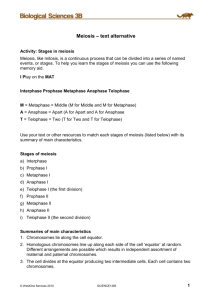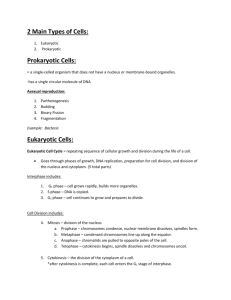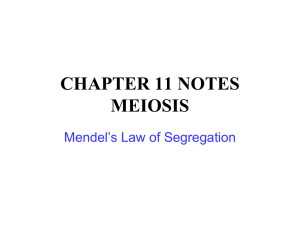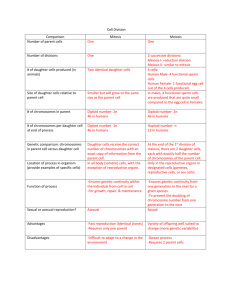Meiosis Follow Along Sheet
advertisement
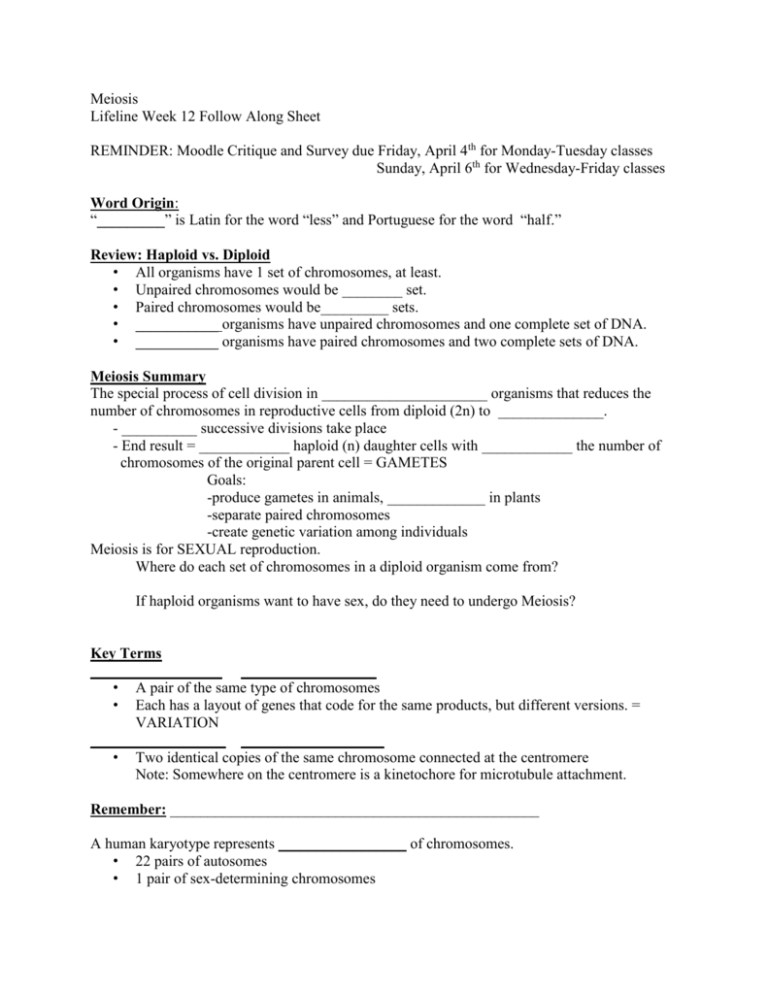
Meiosis Lifeline Week 12 Follow Along Sheet REMINDER: Moodle Critique and Survey due Friday, April 4th for Monday-Tuesday classes Sunday, April 6th for Wednesday-Friday classes Word Origin: “_________” is Latin for the word “less” and Portuguese for the word “half.” Review: Haploid vs. Diploid • All organisms have 1 set of chromosomes, at least. • Unpaired chromosomes would be ________ set. • Paired chromosomes would be_________ sets. • ___________ organisms have unpaired chromosomes and one complete set of DNA. • ___________ organisms have paired chromosomes and two complete sets of DNA. Meiosis Summary The special process of cell division in ______________________ organisms that reduces the number of chromosomes in reproductive cells from diploid (2n) to ______________. - __________ successive divisions take place - End result = ____________ haploid (n) daughter cells with ____________ the number of chromosomes of the original parent cell = GAMETES Goals: -produce gametes in animals, _____________ in plants -separate paired chromosomes -create genetic variation among individuals Meiosis is for SEXUAL reproduction. Where do each set of chromosomes in a diploid organism come from? If haploid organisms want to have sex, do they need to undergo Meiosis? Key Terms _______________ __ __________________ • A pair of the same type of chromosomes • Each has a layout of genes that code for the same products, but different versions. = VARIATION ____________ _____ ___________________ • Two identical copies of the same chromosome connected at the centromere Note: Somewhere on the centromere is a kinetochore for microtubule attachment. Remember: _________________________________________________ A human karyotype represents _________________ of chromosomes. • 22 pairs of autosomes • 1 pair of sex-determining chromosomes • • Chromosomes pair up based on the _________ and ______________ position of each chromosome. Humans have a total of: • 23 homologous pairs • 46 chromosomes Where does Meiosis take place? • In the ___________ CELLS… How many cell divisions occur? • 2 What is the purpose? • ______________ __________________ • _____________ the # of chromosomes The final products: • Four daughter cells whose chromosome number is _______________ But why?? Because during fertilization, the diploid state will be restored. Meiotic Cell Division • Interphase • • • • Prophase I Metaphase I Anaphase I Telophase I / Cytokinesis Meiosis I: Goal: Separation of ______________ ________________ • • • • Prophase II Metaphase II Anaphase II Telophase II / Cytokinesis Meiosis II: Goal: Separation of ______________ ________________ Interphase • ______ a stage of meiosis (or mitosis), but comes before each process • 3 Phases • _______ – Cell grows • _______ – DNA Replication • _______ – Necessary proteins synthesized * Checkpoints ensure that everything goes smoothly and that there are no errors! Meiosis I The main purpose: • Separation of Homologous Chromosomes The Stages: Prophase I: • Chromosomes begin to condense. • • • • • Homologous chromosomes pair up (called ______________) to form a ___________, held together by a synaptonemal complex. Formation of ______________ apparatus Breakdown of nuclear envelope Microtubules attach to ________________ at centromeric regions. Crossing over occurs at ________________. • An exchange of genetic information between a homologous pair of chromosomes (NOT SISTER CHROMATIDS!) • to increase genetic variation Metaphase I • _______________ become arranged on the metaphase plate. • Each chromosome of a tetrad is attached to a microtubule from opposite centrosomes. • *_______________ ________________ * • The random alignment of chromosomes on the metaphase plate causes a plethora of different, possible “assortments.” Anaphase I • ______________ _______________ are pulled apart toward opposite poles by the spindle apparatus. • _____________ ________________ remain attached at the centromere and move as a single unit towards a pole. • Homologous pairs officially separated -Each side of the cell now has a mixture of maternal and paternal chromosomes. Telophase I and Cytokinesis • Each half of the cell has a ______________ set of chromosomes. • Nuclear envelope may re-form; chromosomes may relax to chromatin. • _________________ creates two daughter cells. After Meiosis I, the total number of chromosomes is __________________. • A ____________ cell will have become two ___________ cells. 2n n Meiosis II The main purpose: • Separation of the _____________ _____________ The Stages: • Prophase II • Metaphase II • Anaphase II • Telophase II / Cytokinesis Notice that the stages are the same as Meiosis I, but the purpose is different! • • • Similar to _____________ in that you end up with the same number of chromosomes with which you started nn Allows for direct separation of the sister chromatids and the production of ______ haploid daughter cells (GAMETES!) An _____________ ______________of each of the two cells produced in Meiosis I, which is why ________ ______________ daughter cells are produced Meiosis vs. Mitosis Meiosis • Two successive divisions of a diploid (2n) cell • Results in four haploid (n) daughter cells, each with half of the genetic material of the original cell. • Through independent assortment and crossing-over, creates genetic variation between the daughter cells and parent cells. Mitosis • Singular division of diploid OR haploid cell • Produces 2 daughter cells identical to the parent cell “What you start with is what you end with.”

